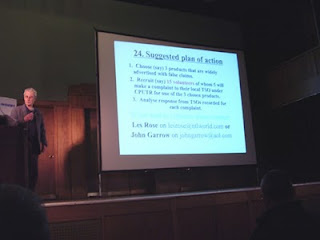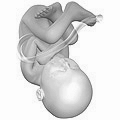 This will be a relatively quick summary of the remaining two talks in the Trick or Treatment? meeting I mentioned in my prior post.
This will be a relatively quick summary of the remaining two talks in the Trick or Treatment? meeting I mentioned in my prior post.The second speaker was Andy Lewis, better known as "Le Canard Noir" of the Quackometer website. His talk was a funny and entertaining look at alternative medicine down the ages. After a brief discussion of Bath, a city whose modern wealth was, to an extent, founded on alternative medicine, he turned to tractors. No, not that sort. These were, in fact, pointed metal rods that supposedly pulled out (hence 'tractor') malign electrical energies from a patient.
These things were very popular in their day, and were cited as having successfully cured a number of conditions. The crucial point here is that these devices were invented by a man named Elisha Perkins, around 1795, just a few years after Samuel Hahnemann invented homoeopathy. So why is it that we all know about Hahnemann's technique, but not Perkins'? There are probably changes in fashion that are relevant here. Perkins' tractors relied on electricity, which was a very cool and mysterious sounding sort of thing at the time - a bit like the use of the word 'quantum' these days in all manner of pseudoscience. The fact that Perkins was out to make a lot of money, and patented his devices, is probably also significant - his techniques required special kit that you could only buy from his company. Hahnemann, by contrast, spread his ideas widely, intentionally making it easy for other people to copy him, and for his technique to long outlive his death.
 Lewis presented a list of features that any good alternative medical treatment should have if it is do well - one almost certainly needs a bit of luck and promotional skill as well, of course. He discussed Hopi ear candles, which you stick in your ear and light up to draw out noxious substances. (Which they apparently don't, in case you were wondering). These are an example of an alternative medical technique that claims an ancient pedigree to make itself sound more impressive. Supposedly, they were used by the Hopi tribe, whose origins date back at least eight centuries. Yet, interestingly, the Hopi themselves deny this, and say it has nothing at all to do with their culture. In fact, there doesn't appear to be any clear evidence that the candles existed before their manufacturer went into business in the late 20th century.
Lewis presented a list of features that any good alternative medical treatment should have if it is do well - one almost certainly needs a bit of luck and promotional skill as well, of course. He discussed Hopi ear candles, which you stick in your ear and light up to draw out noxious substances. (Which they apparently don't, in case you were wondering). These are an example of an alternative medical technique that claims an ancient pedigree to make itself sound more impressive. Supposedly, they were used by the Hopi tribe, whose origins date back at least eight centuries. Yet, interestingly, the Hopi themselves deny this, and say it has nothing at all to do with their culture. In fact, there doesn't appear to be any clear evidence that the candles existed before their manufacturer went into business in the late 20th century.There was also some discussion of how some early examples of a book about "natural medicine" by John Wesley, better known as the founder of Methodism. There were a great many remedies in this book, and a lot of them involved turnips. It's interesting to note that many of these would actually have been quite effective. While its unlikely that, say, rubbing turnips into a woman's breasts will cure very much (although I'm sure a few people would be willing to give it a try), Wesley's recommendation that they be used to treat scurvy would have been quite sound. Not only do turnips contain vitamin C, but, for most people of the day, they would have been much easier to get hold of than lemons.
 The last speaker of the day was Professor John Garrow, of HealthWatch. He has spent much of his career studying obesity, and discussed a number of alternative treatments that, essentially, promise to get rid of your flab without any actual effort on your part. Which one can certainly see the appeal of, but, as you might imagine, tends not to work very well.
The last speaker of the day was Professor John Garrow, of HealthWatch. He has spent much of his career studying obesity, and discussed a number of alternative treatments that, essentially, promise to get rid of your flab without any actual effort on your part. Which one can certainly see the appeal of, but, as you might imagine, tends not to work very well.His particular focus was on HealthWatch's efforts to fight misleading adverts for such cures, through the Advertising Standards Authority and Trading Standards Officers. In particular, he mentioned the Consumer Protection from Unfair Trading Regulations, which effectively outlaws dodgy advertising of this type - but which has never been used to prosecute anyone since its introduction in 2008. HealthWatch itself having so far failed to get apparent breaches of the regulations prosecuted, he proposed a wider study to determine whether there is any will on the part of the relevant officials to do so. If there should, for some reason, turn out to be a systematic bias against enforcing the regulations in the UK, then that would be a violation of British commitments to the EU, and action could potentially be taken on those grounds.





